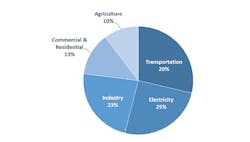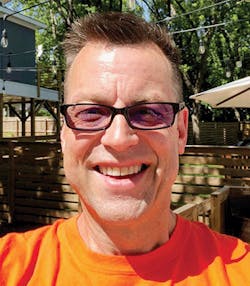Opportunity knocks in energy transition
While our changing climate presents daunting challenges, there’s even greater upside potential, according to Mark Kennedy. He believes the worldwide call to action we face also offers incredible possibilities for collaboration, innovation and value creation—instead of obliteration.
Kennedy recently joined SICK, the global sensor solution provider in industrial and process automation sectors with longstanding roots in safety and environmental applications. He now helps lead the company’s new Solutions for Cleaner Industries initiative, focused on supporting customers’ efforts to employ low-carbon energy sources and industrial process streams.
Control caught up with Kennedy to discuss the challenges and opportunities the evolving global energy transition presents to SICK and, more broadly, the industrial control and instrumentation community overall.
Principal Consultant, EcoInnovation, Solutions for Cleaner Industries, SICK
Q: For those not familiar with the term “global energy transition,” can you explain its meaning and implications for industry?
A: “Global energy transition” refers to the worldwide shift in energy production, distribution and utilization, along with associated industrial process flows, away from fossil-based sources to renewable energy sources. This energy transition is integral to the quest to decarbonize economies in order to achieve net-zero harmful emissions by 2050, thereby limiting average temperature increases worldwide to less than 2°C by the year 2100, above which irreparable damage to the biosphere would occur. Most nations, companies and organizations are taking these goals very seriously and have publicly pledged material and financial support.
As for the world’s industrial ecosystem, the global energy transition involves the “cleaning and greening” of industrial processes, coupled with the implementation of policies to catalyze the colossal morphing required of industrial infrastructures.
The primary lanes on the road to a net-zero global economy include:
- Eliminating and reducing harmful emissions;
- Enacting policies that drive transition, innovation, investment and workforce readiness;
- Equitably funding and implementing the global energy transition; and,
- Changing energy-related behaviors.
Q: Which parts of the world’s energy system will be impacted by the global energy transition?
A: The simple answer is—all parts. Every type of existing and emerging energy system, distribution infrastructure, and virtually all utilization will be impacted.
Why? Because even if we stopped all “dirty” energy and processes today to eliminate harmful emissions, there are nowhere near enough clean and green functional substitutes in place to satisfy global demand. The use of wind, solar and other renewables has grown dramatically, but those sources still only represent a fraction of that needed for the world’s increasing energy appetite. We will need all forms of energy to facilitate a smooth energy transition, which actually gives us the best chance of hitting 2050 targets.
While efficiencies of today’s energy sources can always be improved, the technology “stacks” required for a net-zero or net-negative future exist right now. It’s currently a game of deployment and scale, which means opportunity for almost everyone along the energy value chain, including consumers.
Additionally, no existing energy categories will completely disappear. All net-zero forecasts project the retention of some portion of existing major energy sources. So, everyone gets to continue to play in some fashion — at least for the next 30 years or so.
Q: What opportunities does the global energy transition present to industrial markets?
A: Resulting opportunities for the world’s industrial ecosystem are massive. The energy-related capital expenditure pie will grow tremendously, with the potential to raise everyone up with its growth.
Estimates of global annual energy investment are forecast to increase 2x to 3x current levels of around $2 trillion USD to an average of $4 to $5 trillion—at least until the year 2050, and probably beyond.
Coupling expected global population growth with average per capita energy consumption forecasts means clean generation and remedial investment on the order of starting up multiple gigawatt power plants every day for the next several decades. An annual investment of $3 trillion effectively equates to a daily spend of more than $8 billion. The world has never seen this sort of investment intensity. It is truly historically unprecedented—and extremely exciting.
Q: COP26, the 26th UN Climate Change Conference, just wrapped up in Glasgow. What was your take on those proceedings?
A: Governments and industrials still must rapidly bridge the gap between words and action, but overall, I was encouraged. The world has never seen this degree of global collaboration, which can only be a good thing.
All the key players eventually participated. In between the requisite one-upmanship of dignitaries and delegates, substantive additional commitments were made to those of the Paris Accord. And, the U.S. is back and all-in, pledging more than half a trillion dollars in clean and green funding, which should have cascading positive effects. Important methane emissions mitigation and re-forestation commitments were also announced.
It’s important to keep in mind that it’s not all about technology. Technology is just one vehicle we can employ to improve the human condition. This time, strong non-technical themes throughout COP26 provided overdue recognition of the need for equitable and geographically balanced global deployment of energy transition resources, and gave voice to those regions already suffering from severe climate shifts. Presently, during this holiday season, more than 80 million people are either homeless or are displaced from their homes (the most ever). Of those, 25%-- that’s 20 million people!—are considered to be climate refugees (also the most ever). There is much more at stake here than commercial opportunities. Technology can help.
Q: What role can SICK solutions play in advancing the global energy transition?
A: At the company’s founding 75 years ago by Dr. Erwin Sick, the initial focus was on light-based sensor solutions that could protect personnel from physical hazards inside industrial facilities. From there, straightforward research and development enabled SICK to extend its offering to include protecting people, assets and environments across entire plant sites and infrastructure footprints. From the outset, Dr. Sick instilled a profound respect for nature and sustainable work processes into the company’s culture. He understood the importance of marrying industrial technical progress with responsible treatment of the environment.
Today, SICK leverages diversity of thought and technical discipline to offer customers consulting, systems, and field services in the areas of functional safety, fluids metrology, emissions abatement, machine vision, factory automation and global logistics—all anchored by intelligent sensing. In an increasingly connected and digitally dense world, data provenance and real-time insights will help businesses and industrial ecosystems cope with and thrive in an ever-changing global marketplace.
SICK is well positioned and constantly evolving to help our customers meet their energy transition challenges and prepare for their best future.


